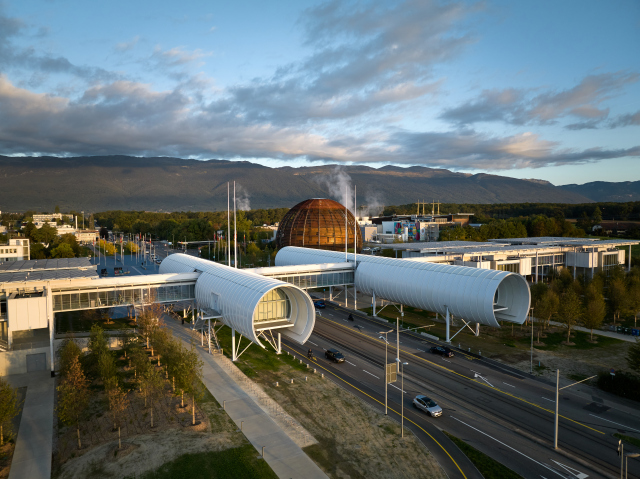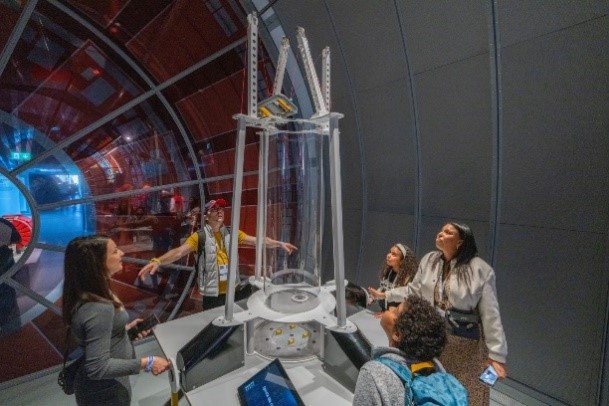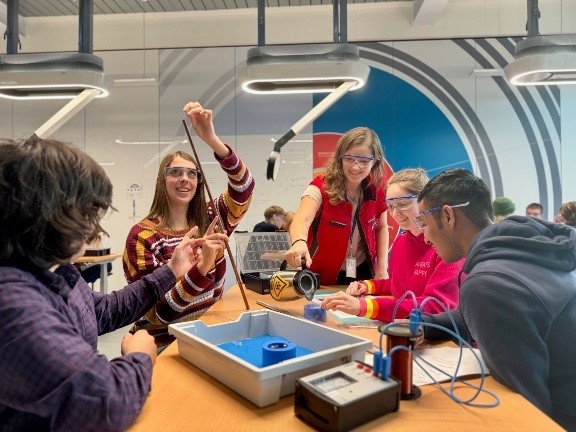CERN Science Gateway: a guide for teachers Inspire article
Discover CERN’s brand-new science education and outreach centre in Geneva, Switzerland: CERN Science Gateway!
Why visit CERN Science Gateway?

© CERN
CERN, which is located in Geneva, Switzerland, is the world’s largest particle physics laboratory. It’s the home of the large hadron collider (LHC), currently the most powerful particle accelerator in the world, which is used to collide particles at incredibly high energies. This enables scientists to study the fundamental interactions between elementary particles. CERN also offers a unique environment for learning and training. In particular, CERN Science Gateway, a brand-new science education and outreach centre that opened on 7 October 2023, offers visiting school groups a rich and authentic out-of-school learning experience.
Why should teachers take up the challenge to organise a trip to CERN Science Gateway?
Particle physics concepts, such as elementary particles, fundamental interactions, and charges, are mentioned explicitly in many science curricula.[1] However, even if particle physics is not listed, there are many options to link the CERN Gateway activities to the curriculum. For example, students can explore the role of experiments and scientific models in research. CERN also provides an exciting context to teach classical physics concepts (why not talk about particle accelerators when teaching circular motion?).

© CERN
Visiting CERN allows students to see first-hand where ground-breaking discoveries are made, and can ignite curiosity and foster an interest in science. Moreover, it can inspire students to pursue careers in science, technology, engineering, and mathematics (STEM). Students can interact directly with volunteers from CERN’s scientific community who play a crucial role in facilitating education activities. They can witness the passion and dedication of scientists and gain insights into the various career paths within the scientific community. Furthermore, CERN is an international institution where scientists and researchers from around the world work together. This can help students appreciate the importance of international collaboration in science and foster a global perspective.
The iconic building was designed by the world-renowned Renzo Piano Building Workshop, with support from Brodbeck–Roulet architectes associés, and its design embraces the industrial feel of CERN. CERN Science Gateway is about creating a space where people can explore CERN and science in a fun and inspiring way and all visits are free of charge. It includes interactive hands-on exhibitions, science shows, and lab workshops, and it also serves as the starting point for guided tours to CERN’s research facilities.

© Maximilien Brice/CERN
Interactive exhibitions
With hands-on experiments, real scientific objects, immersive environments, and interactivity, the three exhibitions at Science Gateway bring CERN to life.
- Discover CERN: try your hand at accelerating particles and explore the extraordinary technologies inside the LHC. Discover how these giant experiments record particle collisions and how a global network of computers processes the data. Hear scientists’ stories about their work and find out how their technology can be used in hospitals.
- Our Universe: take a journey back 13.8 billion years, to the very beginning of time. Discover how the universe evolved to become what we see around us today. An arts space on the theme of ‘Exploring the Unknown’ hosts several new contemporary artworks inspired by the work of CERN scientists on topics such as the emptiness of space, the invisible, and space and time.
- Quantum World: we live in a quantum world! Quantum physics explains why the sun shines. It allows us to make smartphones and to understand how plants grow. But quantum effects only occur at the tiny scales of particles… don’t they? Visit Quantum World to discover the weird and wonderful way the universe works at the smallest of scales.
Recommended age: the exhibitions provide a diverse range of activities centred around open exploration, making them suitable for learners as young as eight. Visitors have the flexibility to choose the depth of accompanying explanatory texts based on their prior knowledge and interests. Online teacher guides are also available to help educators identify exhibits that align with the learning levels of primary or secondary school groups.
Languages: screen texts are available in five languages (French, English, German, Italian, and Spanish)
Duration: we recommend you allow 1.5 to 3 hours to visit the three exhibitions.
Additional information: audio descriptions, video subtitles, and tactile content help to make the content more accessible. Find out more at https://visit.cern/exhibitions.

© Maximilien Brice/CERN
Lab workshops
Have you ever wondered what it’s like to work at the world’s largest physics laboratory? Then book one of our lab workshops and discover your inner scientist. Explore your scientific curiosity while learning how to conduct scientific investigations. Our workshops cover a wide range of topics, from the basic principles of particle detection to the use of robots and the nature of science.
Recommended age: Different workshops are provided based on students’ ages and the group’s interests:
- Slimy detectors (5–7 years)
- Programming with Ozobots (5–7 years)
- Seeing the invisible (5–15 years)
- Magnet challenge (8–12 years)
- LEGO robotics challenge (8–15 years)
- Power of air (8–15 years)
- Cloud chamber (16–19 years)
- Electron beams (16–19 years)
- Superconductivity (16–19 years)
- Positron-emission tomography (16–19 years)
Languages: up to 30 languages, depending on guide availability
Duration: approx. 45 min for ages 5–15 years, 90 min for ages 16–19 years
Additional information: teachers can indicate a preference for a workshop and receive preparation and follow-up material for the selected activity. Find out more at https://visit.cern/lab

© Merten Dahlkemper/CERN
Science shows
Come and watch one of our interactive science shows! See science in real life in a theatre-style setting and take part in the fun activities included in the show. The shows cover everything from states of matter and levitation to electromagnetism and the universe.
Recommended age: most science shows are designed to appeal to a broad range of visitors and are open to school groups as well as individual visitors and families:
- Mysteries of matter (6+ years)
- Journey through a detector (12+ years)
- Seize the data (12+ years)
- Proton express (12+ years)
- Science of magical parties (4–7 years)
Languages: English or French
Duration: 30 to 45 min
Additional information: Shows are scheduled upon availability of the auditorium and are available on a first-come, first-served basis. Find out more at https://visit.cern/shows

© Marina Cavazza/CERN
Guided tours of CERN’s research and engineering facilities
Are you fascinated by physics and engineering? Curious to dive into CERN’s research activities and technological achievements? Take the opportunity to visit fascinating places and hear the stories behind CERN’s research and engineering facilities on a guided tour.
Recommended age: 14+ years
Languages: up to 30 languages, depending on guide availability
Duration: 2 to 3 hours
Additional information: we will adapt your tour programme to your group profile. Please inform us about any constraint (reduced mobility, etc.), you can also specify your areas of interest. Find out more at https://visit.cern/tours-groups

© Maximilien Brice/CERN
Online educational resources
Our educational resources can aid you in preparing for, enjoying, and following up on a visit to CERN Science Gateway, or engaging with it online if you cannot come to CERN physically. We provide a selection of hands-on activities, reading material, videos, animations, and VR/AR material that have been developed in the framework of education and outreach activities at CERN. Find out more at https://visit.cern/resources
Practical details
School groups can visit CERN Science Gateway from Tuesday to Saturday, 9:00 to 17:00, Sundays are reserved for families and individual visitors. All visits are free of charge. However, school groups (12–48 people) need to book in advance. Due to high demand and limited capacity, we recommend submitting your visit request nine months in advance. During the booking process, you will provide information about your group’s profile, select the activities you are interested in, pick an available date, and provide contact information for your group before submitting your request. If no date is available, try again a few days later or reduce the number of selected activities. You will receive a response to your request within five working days. Please ensure that your request has been confirmed before making your travel arrangements. CERN is well-connected by public transport and can easily be reached from Geneva’s airport, conveniently located just outside the city, or the central train station.
Are you ready to plan an exciting journey into the world of science? Go to visit.cern/ to visit CERN!
References
[1] Kranjc Horvat A et al. (2022) What Does the Curriculum Say? Review of the Particle Physics Content in 27 High-School Physics Curricula. Physics 4: 1278–1298. doi: 10.3390/physics4040082
Resources
- Discover what CERN Science Gateway has to offer.
- Learn how Star Wars can be used to engage students with accelerator science: Welsch C P (2021) The physics of Star Wars: introducing accelerator science. Science in School 54.
- Read about the use of proton beams for cancer therapy: Welsch C P (2021) Death Star or cancer tumour: proton torpedoes reach the target. Science in School 55.
- Explore the nature of science by investigating a mystery box without peeking inside: Kranjc Horvat A et al. (2022) The mystery box challenge: explore the nature of science. Science in School 59.
- Explore how physicists study very small and very large objects: Akhobadze K (2021) Exploring the universe: from very small to very large. Science in School 55.
- Discover the different elements of particle accelerators by assembling a virtual one with cardboard cubes and a smartphone: Welsch CP (2021) Build your own virtual accelerator. Science in School 54.
- Identify tracks of subatomic particles from their ‘signatures’ in bubble-chamber photos: Woithe J, Schmidt R, Naumann F (2019) Track inspection: how to spot subatomic particles. Science in School 46: 40–47.
- Find out how you can build an accelerator in a salad bowl: Torres R (2017) A particle accelerator in your salad bowl. Science in School 46: 49–55.
- Build a cloud chamber with your students: Barradas-Solas F, Alameda-Meléndez P (2010) Bringing particle physics to life: build your own cloud chamber. Science in School 14: 36–40.





